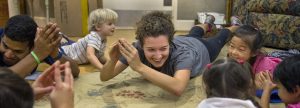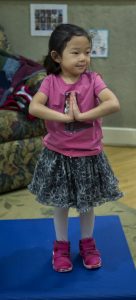It’s Friday afternoon at VCU Health’s MCV Campus Daycare. The preschoolers are just waking up from their naps, eager to tackle the afternoon. They peek through the windows on their classroom doors when they spot a group of medical students in the hallway.

A collaborative initiative created by the VCU School of Medicine’s Pediatric Interest Group and YogaRx student group, Yoga for Preschoolers introduces children in the local community to the benefits of yoga, and introduces medical students to what it will be like to work with their youngest patients.
In groups of six to eight, the preschoolers make their way to the hall to participate in Yoga for Preschoolers, a collaborative initiative created by the VCU School of Medicine’s Pediatric Interest Group and YogaRx student group. [Watch video]
“Find your lily pad,” says M2 Tori Rodgers as she directs the children to their yoga mats. In fall 2016, Rodgers, co-president of the Pediatric Interest Group, reached out to her classmates in YogaRx to develop a partnership. A devotee of yoga herself, she wanted to bring yoga to children in local daycare centers throughout Richmond.
M2 and Yoga Rx president Victoria Keiser jumped on board. A certified yoga teacher who completed a 200-hour yoga teacher training course in May 2016, she had founded YogaRx as a way to bring stress relief to medical students and was eager to expand the group’s reach into the community. Yoga for Preschoolers was born.
“It’s fun working together to make a curriculum for kids and adapting it so kids understand it,” Rodgers says. “It’s interesting to see the kids’ progress. They just soak up everything we give them.”
Developing a yoga curriculum for preschoolers means trading standard yoga terms for kid-speak. Downward dog becomes breathing like a lion. Lying on bellies and stretching becomes hissing like snakes and looking up to see if there’s any danger. “I see a fire-breathing dragon!” Rodgers says as the group squeals.

Yoga for Preschoolers gives children new tools to manage their emotions and their bodies at an early age.
Like any good medical student, she works in some basic knowledge about the body throughout the session. She explains the heart pumps blood as the children put their hands over their hearts to feel the beat and that lungs are for breathing oxygen as they practice taking slow breaths.
Keiser also teaches geriatric yoga once a month through YogaRx and says she enjoys introducing yoga at both ends of the age spectrum. “It’s rewarding to teach any population but even more rewarding to teach kids. We hope that they’ll go back home and talk about what they’ve learned, improving their family’s health, too.”
MCV Campus Daycare director Tracy Walters says the sessions provide an uplifting way to end the day for the preschoolers.
“Yoga brings another level to staying healthy physically and brings in mental health as well,” she says. “It’s a release for them — some children are here 12, 14 hours a day. It’s a big benefit for families who don’t always have built-in time to take them to a lesson.”
Ananda Amstadter, Ph.D., sends her 2-year-old son to the daycare, where he participates in the yoga classes. A researcher and associate professor at the Virginia Institute for Psychiatric and Behavioral Genetics, she sees the benefits for the medical students, too.
“It’s good for the students to work with little humans and de-stress, get some of that toddler energy,” she says.
Keiser’s medical interests lean toward internal medicine rather than pediatrics, but she says the experience working with children outside the doctor’s office has helped prepare her for pediatric rotations and what to expect from her youngest patients.
“They may take something completely differently than the way you meant it, and you just have to go with it,” she says. “If you keep that mentality, it’s less intimidating when we do work with kids down the road and it will make it more fun.”
Walters says it’s good for the students to see from an early point in their careers that every child is different and giving thought to your approach is so important because you “make it or break it” with a child in those first interactions.
As the session winds down, the wiggly students who came into the hallway are now lying still on their “lily pads,” relaxing. Rodgers ends the class with the traditional yoga salutation, “Namaste,” before the preschoolers head back into their classrooms.
The medical students seem more relaxed, too, as they gather by the door and chat about the upcoming exam on Monday. When asked what they would be doing on a typical Friday afternoon if they weren’t with the preschoolers, they all answer in unison: “studying.”
That makes their commitment to the monthly sessions all the more impressive, Walters says. “For our parents, because many of them have been medical students themselves, they know the demands and find particular delight in the students sharing their time and talent with their children. It’s been a real gift.”
Susan R. DiGiovanni, M’84, H’87, F’89, senior associate dean for medical education and student affairs, sees the benefit, too. “This a great learning experience for the students as well as a way to de-stress,” she says. “You cannot stress over exams when you are giggling with a toddler!”
By Polly Roberts